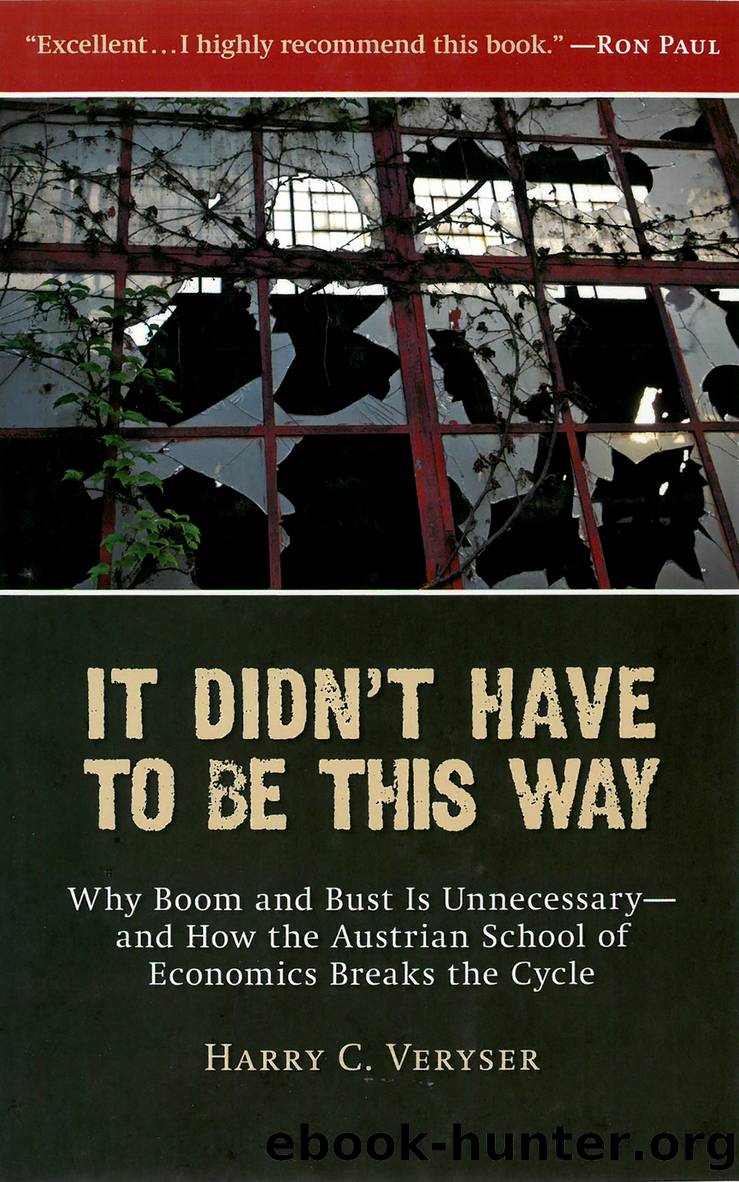It Didn't Have to Be This Way by Harry Veryser

Author:Harry Veryser
Language: eng
Format: epub
Publisher: Regnery Gateway
Published: 2023-12-12T00:00:00+00:00
Four Influences on the Division of Labor
Four types of change affect the division of labor in any economy, be it local, state, national, or international. Those four influences are: seasonal, frictional, structural, and cyclical. All these types of change occur simultaneously, interacting with one another.
Seasonal change: Seasonal changes are the simplest and therefore the easiest to understand. Natural seasons affect the economy because of changes in weather. The winter months spur increases in snowmobiling, skiing, and trips to warmer climes. Summer brings boating, light clothing, and beach-house rentals. Since the seasons follow a natural rhythm, manufacturers, travel agencies, and retailers can all plan to have the necessary goods and services available for purchase at the appropriate times. In addition, the financial community can make credit available before the season and expect repayment at the end of the season.
A second type of seasonal change follows societyâs conventions. These so-called conventional changes include all the shopping spikes that occur at Christmas, Valentineâs Day, Motherâs Day, and the like. These predictable selling seasons shape the plans of retailers, manufacturers, and many other businesses. Florists, for example, count on huge sales on February 14 and Motherâs Day. If sales fall far below expectations at those times, it will be an unprofitable year. Similarly, retailers look to the Christmas shopping season as their make-or-break period. The day after Thanksgiving has come to be known as âBlack Fridayâ at least in part because that busiest day of the shopping year marks the switch from red ink to black ink in a retailerâs books.
The state of hiring follows seasonal changes. Teachers, resort workers, ski instructors, farm laborersâthese and many other workers often prepare to take two separate jobs, one for the season and one for the offseason. Because the seasons (natural and conventional) are predictable, the division of labor will react accordingly.
Frictional change: Economists use the term frictional unemployment to refer to the period after a person leaves one job but before he or she can find another. For instance, someone may be so dissatisfied with pay or working conditions that he quits before lining up another job. But the concept of frictional change can be extended beyond unemployment to other aspects of the economy, such as investment and capital allocation. Sometimes the financial rewards available in one line of work or industry are not enough to justify keeping resources in it. Investors may determine that the risk of a specific investment may be too high to justify the potential return; they pull their investment out without knowing where they will invest their capital next. Or they could pull back from the stock market altogether because of uncertain economic conditions that they fear will lead to a bear market. In either case, they hold out until a good opportunity comes along.
Whereas seasonal changes are highly predictable, frictional changes are much harder to read. One can try-to guess how frictional changes are playing out by watching certain economic indicators such as interest rates on Treasury bills or business closures.
Download
This site does not store any files on its server. We only index and link to content provided by other sites. Please contact the content providers to delete copyright contents if any and email us, we'll remove relevant links or contents immediately.
International Integration of the Brazilian Economy by Elias C. Grivoyannis(90817)
The Radium Girls by Kate Moore(11921)
Turbulence by E. J. Noyes(7935)
Nudge - Improving Decisions about Health, Wealth, and Happiness by Thaler Sunstein(7615)
The Black Swan by Nassim Nicholas Taleb(7010)
Rich Dad Poor Dad by Robert T. Kiyosaki(6399)
Pioneering Portfolio Management by David F. Swensen(6226)
Man-made Catastrophes and Risk Information Concealment by Dmitry Chernov & Didier Sornette(5921)
Zero to One by Peter Thiel(5685)
Secrecy World by Jake Bernstein(4643)
Millionaire: The Philanderer, Gambler, and Duelist Who Invented Modern Finance by Janet Gleeson(4374)
The Age of Surveillance Capitalism by Shoshana Zuboff(4209)
Skin in the Game by Nassim Nicholas Taleb(4161)
Bullshit Jobs by David Graeber(4094)
The Money Culture by Michael Lewis(4076)
Skin in the Game: Hidden Asymmetries in Daily Life by Nassim Nicholas Taleb(3929)
The Dhandho Investor by Mohnish Pabrai(3698)
The Wisdom of Finance by Mihir Desai(3650)
Blockchain Basics by Daniel Drescher(3506)
